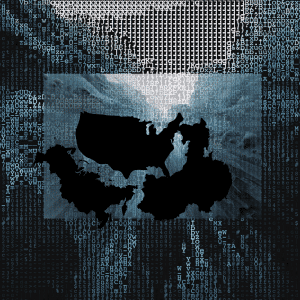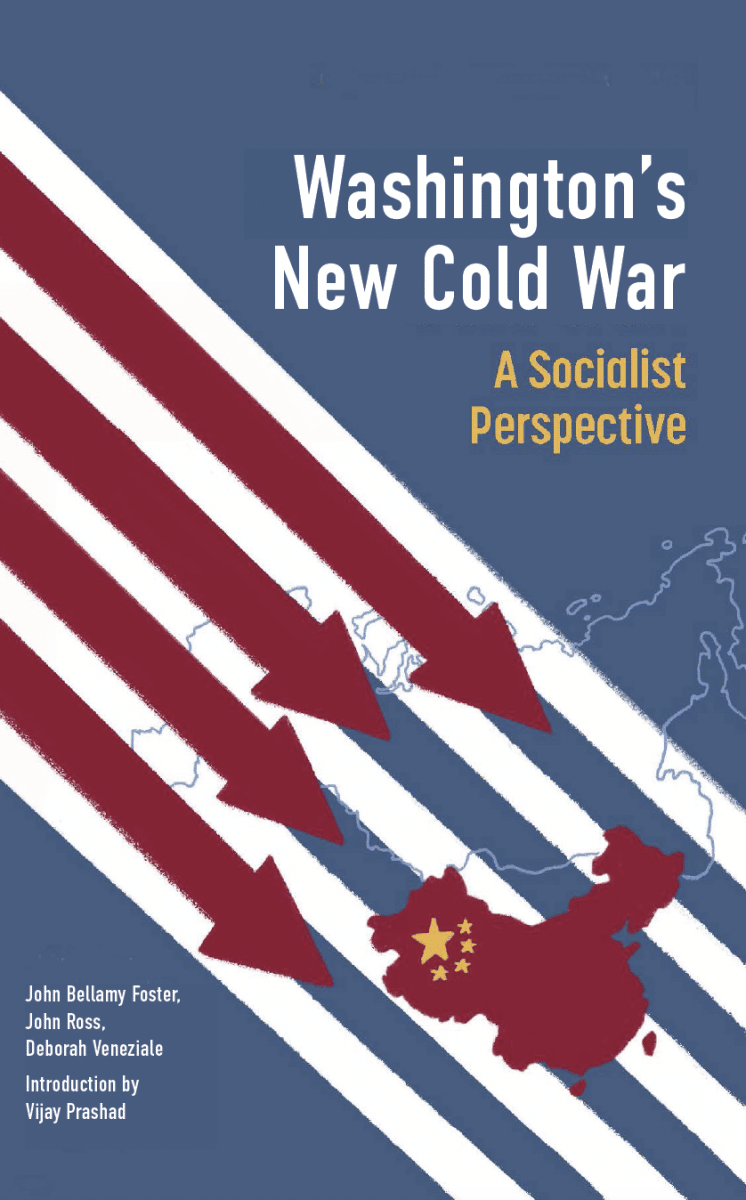NEW! Washington’s New Cold War:
A Socialist Perspective
By John Bellamy Foster,
John Ross, and Deborah Veneziale
With an introduction by Vijay Prashad
$15 paper / 108 pages / 978-1-68590-000-7
EXCERPTS:
“Notes on Exterminism” for the Twenty-First-Century Ecology and Peace Movements
By John Bellamy Foster
In 1980, the great English historian and Marxist theorist E. P. Thompson, author of The Making of the English Working Class and leader of the Movement for European Nuclear Disarmament, wrote the pathbreaking essay “Notes on Exterminism, the Last Stage of Civilization.” Although the world has undergone a number of significant changes since, Thompson’s essay remains a useful starting point in approaching the central contradictions of our times, characterized by the planetary ecological crisis, COVID-19 pandemic, New Cold War, and current “empire of chaos”—all arising from features deeply embedded in the contemporary capitalist political economy.
For Thompson, the term exterminism referred not to the extinction of life itself, since some life would remain even in the face of a global thermonuclear exchange, but rather to the tendency toward the “extermination of our [contemporary] civilization,” understood in its most universal sense. Nevertheless, exterminism pointed to mass annihilation and was defined as consisting of those “characteristics of society—expressed in differing degrees, within its economy, its polity, and its ideology—which thrust it in a direction whose outcome must be the extermination of multitudes.”
“Notes on Exterminism” was written eight years before climatologist James Hansen’s famous 1988 testimony on global warming to the U.S. Congress and the formation that same year of the UN Intergovernmental Panel on Climate Change. Hence, Thompson’s treatment of exterminism focused squarely on nuclear war and did not directly address the other emerging exterminist tendency of contemporary society: the planetary ecological crisis. Yet, his perspective was a deeply socioecological one. The tendency toward exterminism in modern society was thus seen as directly opposed to “the imperatives of human ecological survival,” demanding a worldwide struggle for a socially egalitarian and ecologically sustainable world.
With the demise of the Soviet Union and the end of the Cold War in 1991, the nuclear threat that had loomed over the planet since the Second World War seemed to subside. As a result, most subsequent considerations of Thompson’s exterminism thesis have considered it primarily in the context of the planetary ecological crisis, itself a source of “the extermination of multitudes.” However, the advent of the New Cold War over the last decade has brought the threat of nuclear holocaust back into the center of world concerns. The 2022 Ukraine War, the origins of which date back to the 2014 U.S.-engineered Maidan coup and the resulting Ukrainian Civil War fought between Kyiv and the breakaway republics of the Russian-speaking Donbass region in Ukraine, has now evolved into a full-scale war between Moscow and Kyiv. This took on an ominous worldwide significance on February 27, 2022, with Russia, three days into its military offensive in Ukraine, placing its nuclear forces on high alert as a warning against a direct NATO intervention in the war, whether by non-nuclear or nuclear means. The potential for a global thermonuclear war between the leading nuclear powers is now greater than at any time in the post–Cold War world.
It is therefore necessary to address these dual exterminist tendencies: both the planetary ecological crisis (including not only climate change but also the crossing of the eight other key planetary boundaries that scientists define as essential for the Earth’s ability to be a safe home for humanity) and the growing threat of global nuclear annihilation. In approaching the dialectical interconnections between these two global existential threats, emphasis must be placed on updating the historical understanding of the thrust toward nuclear exterminism as it metamorphosed in the decades of U.S. unipolar power, while the world’s attention was directed elsewhere. How is it that the threat of global thermonuclear war is once again hanging over the globe, three decades after the end of the Cold War and at a time when the risk of irreversible climate change looms on the horizon? What approaches need to be adopted within the peace and environmental movements to counter these interrelated global existential threats? To answer these questions, it is important to address such issues as the nuclear winter controversy, the counterforce doctrine, and the U.S. quest for global nuclear supremacy….
What Is Propelling the United States into Increasing International Military Aggression?
By John Ross
The United States was aware that extending NATO into Ukraine would directly confront the national interests of Russia, a country with large military forces and an enormous nuclear arsenal. Though it would cross Russia’s red lines, the United States was ready to take this risk.
…The United States and its allies have been preparing Ukraine for war since at least 2014, such as by sending hundreds of instructors to train Ukraine’s military. This is similar to its approach during the Gulf War in Iraq in 1990, reflecting a model that Washington appears to be using to achieve its geopolitical goals. Russia was purposefully lured into the situation in Ukraine beginning with the 2014 coup, when anti-Russian forces took power in Kiev, backed by Ukrainian neo-Nazis as well as by the United States. At that time, the Ukrainian army was not a powerful military force, having suffered considerably following the “reforms” launched in 1991, after the collapse of the Union of Socialist Soviet Republic (U.S.S.R.). Decades of neglect and underfunding led to decaying military infrastructure and equipment, along with the depletion of morale among officers and soldiers….
…During the 2014–15 war against Donbass (the Russian-speaking region of eastern Ukraine), Ukraine had little air combat support, as nearly all combat aircraft were in need of repair. However, by February 2022, the air force was equipped with approximately 150 fighters, bombers, and attack aircraft. The size of the Ukrainian armed forces also expanded dramatically. It is important to note that, at the end of 2021, remuneration for soldiers increased three-fold, according to Tetekin’s data. This strengthening of military power alongside powerful fortifications erected near Donbass indicates the U.S. intention to initiate conflict in the region.
However, despite these preparations for war, the Ukrainian army was unable to seriously contest with Russia. The balance of forces was clearly not in favor of Kiev. This did not matter to the United States, which sought to use Ukraine as cannon fodder against Russia. According to Tetekin, “the United States planned two options for the new, militarized Ukraine… The first one was to conquer Donbass and invade Crimea. The second option was to provoke Russia’s armed intervention.”
In December 2021, aware of the growing danger it faced from Ukraine under U.S. influence, Russia sought a set of security guarantees from NATO to defuse the crisis. In particular, Russia demanded that NATO end its eastward expansion, including membership of Ukraine. “The West . . . ignored these demands,” Tetekin writes, “knowing that preparations for the invasion of Donbass [were] in full swing. Most combat-ready units of the Ukrainian Army, numbering up to 150 thousand people, were concentrated close to Donbass….
Who Is Leading the United States to War?
By Deborah Veneziale
In 2019, the prominent neoconservative Robert Kagan co-authored an article with Antony Blinken urging the United States to abandon Trump’s America First policy. They called for the containment (i.e., siege and weakening) of Russia and China and proposed a policy of “preventive diplomacy and deterrence” against America’s adversaries, that is, troops and tanks wherever it is deemed necessary.11 Incidentally, Kagan’s wife, Victoria Nuland, served as the assistant secretary of state for European and Eurasian affairs in the Obama administration. Nuland played a key role in organizing and supporting the 2014 color revolution/coup in Ukraine and has boasted about the billions of dollars the United States has spent to “promote democracy” in the country.12 She is currently serving as undersecretary of state for political affairs in the Biden administration, the third-highest position in the State Department after Secretary Blinken and Deputy Secretary Wendy Sherman. She is also a spiritual heir to her mentor, the liberal hawk leader Madeleine Albright.
The hawkish orientation espoused by Kagan and Blinken was taken a step further by NATO’s think tank, the Atlantic Council, which has advocated for nuclear brinkmanship. In February, Matthew Kroenig, the deputy director of the Atlantic Council’s Scowcroft Center for Strategy and Security, argued for the consideration of the U.S.’s preemptive use of “tactical” nuclear weapons.
From this small coterie of warmongers, one can easily detect the deep integration of two elite foreign affairs groups, both of which are the real drivers of the Ukraine crisis. The evolution of this crisis reveals the following set of tactics adopted by this belligerent clique:
Ÿ*strengthening U.S. leadership over NATO, using the military alliance (rather than the UN) as the primary mechanism for foreign intervention;
Ÿ*provoking a so-called adversary to war by refusing to recognize its claim to sovereignty and security over sensitive regions;
Ÿ*planning the use of tactical nuclear weapons and conducting a “limited nuclear war” in or around the so-called adversary’s territory; and
Ÿ*imposing hybrid warfare in order to weaken and subvert the adversary through unilateral coercive measures and combining economic sanctions with financial, informational, propagandistic, and cultural measures along with a color revolution, cyberwarfare, lawfare, and other tactics.
If the desired results are achieved in Ukraine, the same strategy will undoubtedly be replicated in the Western Pacific.
Strategic alignment does not mean that policy elites are not divided on other issues that they deem to be of lesser importance, such as climate change. Even on this matter, however, the United States is demanding that Europe stop importing natural gas from Russia. John Kerry, Biden’s climate envoy, is noncommittal about the potential negative environmental impacts of such a move, in part because the United States wants to replace Russian gas sales in Europe with its own.
In recent years, progressive forces around the world have launched several international campaigns to voice their concerns about the aggressive global strategy being pursued by the U.S., often using the term “New Cold War.” However, the narratives put forth at times underestimate the depravity of some aspects of current U.S. foreign policy. The “Old Cold War” with the Soviet Union followed certain rules and bottom lines: the United States used a variety of political and economic means to exert pressure and seek to subvert the Soviet state, and the two sides acknowledged one another’s scope of interests and security needs. However, the U.S. did not try to change the national boundaries of nuclear adversaries. This is not the case today, as seen by the Wall Street Journal’s open declaration that the United States should demonstrate its ability to win a nuclear war, a stance which is undergirded by the foreign policy elite’s claim that Ukraine and Taiwan must be protected as they are both strategic locations within the Western military perimeter.14 Even the Cold War leader Kissinger has expressed concern and opposition to current U.S. foreign policy, arguing that the correct strategy is to divide China and Russia and warning that there will be dangerous consequences if the U.S. directly pursues war against these two nuclear-armed states simultaneously….
To read more, get a copy by clicking on the cover below


Comments are closed.